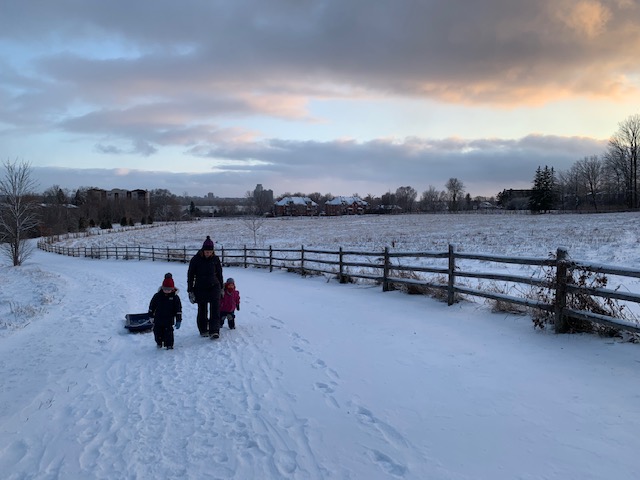What will the world look like in 2035?
Speedy Timeline
In the week before school closed face to face instruction for the now extended Christmas break, a grade 6 English as a Second Language (ESL) student of mine here in a Quebec primary school was excitedly showing me her timeline of the paintbrush. The exercise was to describe the past, present and future of an everyday object. Each student in the class chose a different gadget or app as their topic for the presentation. Their choice of wonderful inventions ranged from the wrist watch to Tik Tok, from the toaster to Playstation 5.
The students then shared their timelines of their wonderful inventions with each other in short small group exchanges otherwise known as a Gallery Walk. As we listened and commented on the presentations using exit tickets, an interesting pattern emerged: some things like pencils, paintbrushes, utensils have not changed much over the past 50+ years. These standard everyday objects do not need to be reinvented. They have been around for centuries with only slight modifications. Other things are evolving at an alarming rate. Take, for example, music streaming during the course of my lifetime. I can remember the famous mix tape where we would have to sit by the radio and press Record at just the right time in order to copy our favorite pop song. Then came the revolutionary Compact Disc (CD) which contained an overwhelming 80 minutes (gasp!) of music. Followed by MP3s, and in quick succession the Ipod from Apple. Fast forward just 20 years and this weekend, my five year old son taught himself to use the voice command with Alexa Echo Dot and easily has the compete repertory of classical, pop and rock music at his disposal! What a rapid evolution of how we access and listen to music in a relatively short period of time.

The Good Old Days
I remember getting my first desktop computer back in the 90s. We bribed my dad to stop smoking in order to convince my mum to buy us a computer. This was before the World Wide Web. We were happy to type in word and awed by the choice of 30 unique fonts. I could not imagine an iPhone, smartphone, apps, electric car, or of a Coronavirus that would force everyone to stay home and be apart for days, weeks, and months on end.
The rate at which gadgets and technology are evolving is exponential. New fads become obsolete in less than a generation. Take for example: Blackberry, Sony Walkman, BlueRay DVD player, and Hummer are brand names that have all but disappeared from our everyday vocabulary -along with the dodo bird. An eleven year old student looked perplexed as I tried to explain that my first Nokia cell phone did nothing more than make and receive phone calls and light up as a flashlight. “What else did you do with your phone?” the students asked. I had to explain that texting came later; then followed apps and social media. After an awkward moment of silence and one short pause, the grade 6 student exclaimed out loud: “Imagine me telling my kids: I used to have to drive my own car. Because they’ll all be diver-less when we are adults.” We all burst out laughing. But there is an element of truth to her seemingly wild statement.
What will the world look like in 2035?
Close your eyes and try to imagine what will the workplace look like in 2035? Will we all be working from home? Will robots have taken over standard menial jobs such as cleaning or store checkouts and will these robots be flying us in our personal airplanes through space? I’m not trying to complete with George Orwells novel 1984 here. However, the year 2035 is when when my young daughter will come of age and she will be entering the workforce for the first time. How do we prepare her for a world we can barely imagine? What is my role as a teacher? What is my responsibility as a parent? How do we prepare our children today for the unchartered reality of tomorrow?
Leaning How to Learn
I don’t presume to have all the answers here. But I would start off by answering this rhetorical question with the notion that instead of teaching facts and notions -we should broaden the approach to encompass learning how to learn. We want the adults of tomorrow to be critical thinkers, innovators, optimists.
We don’t need to teach children how to use technology. My son discovered the unlocked iPad in my school bag and in less than 5 minutes was happily playing on the programming app Tortue Logique. He figured it out all by himself.
Instead we must prepare these students for the future: to be curious, to know how to filter the information they receive. How to think outside the box. To not be afraid to use their creativity and to try something new. This includes modeling empathy and fostering a social conscience.
Learn By Doing
Although we practiced the traditional Christmas songs in English class this year, the big school concert in the gym was canceled. Instead, I filmed each class and shared the video montage. For the bonus activity, I suggested my students learn the song, pick a friend or relative, and sing to them over the phone (or by video.) I wrapped up this activity with a Self-Evaluation: How did it make you feel? How did it make the receiver feel?
At my elementary school, we asked our grade four students to make Christmas cards for the elderly living in care homes who can not receive visitors this Christmas season. The students were very happy to do so. Simple gesture which as a lasting impact. Empathy is modeled not a learned behavior. Experiential learning. By doing.
I included a few more on my website the Padlet: English with Miss Amy.

As I sit by the fire and look out the window, I watch the empty street on a Friday night. I notice that there are many more people out walking than before. More neighbors have put up twinkling Christmas and Hanukkah lights in an attempt to brighten the mood during these dark and cold winter months. My daughter is convinced that the house with the bright pink outdoor lights is where she will live when she becomes a grownup princess. She adds: “I wonder what my house will look like from space?”


